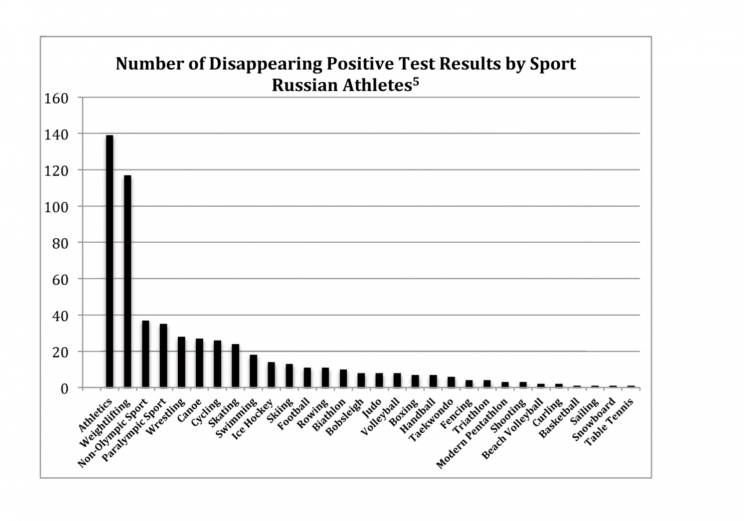The 10 most shocking findings from WADA's report on Russia’s state-sponsored doping program
The World Anti-Doping Agency released Monday the findings of an independent report that confirmed allegations of a Russian state-sponsored doping program.
Professor Richard McLaren conducted a number of witness interviews, reviewed thousands of documents, performed cyber and forensic analysis of hard drives, urine sample collections and laboratory analysis of individual athlete samples to detail the extreme measures Russian officials took to ensure their athletes tested clean at major events including the 2012 Summer Olympics in London and the 2014 Olympics in Sochi.
WADA has since called for a blanket-ban on all Russian athletes aiming to compete at the upcoming Olympics in Rio de Janeiro.
Here are the 10 most shocking revelations from McLaren’s 103-page report.
1. Russia’s doping program and cover-up operated under the guise of state officials.
Following a poor showing at the 2010 Winter Olympics in Vancouver, Russian president Vladimir Putin designated a new Deputy Minister of Sport, Yuri Nagornykh. A “plan to ensure lots of medal winners” was then concocted by Minister of Sport Vitaly Mukto, Nagornykh, Director of the Center of Sports Preparation of National Teams of Russia, Irina Rodinova, and the Russian national security force, the FSB. The plan included developing methods for hiding positive results, swapping urine samples at the 2014 Sochi Olympics and creating a steroid cocktail that would be not detected by anti-doping officials at the 2012 London Olympics.
Should any part of Russia’s program be revealed, the drug-testing laboratory in Moscow was set up so that its employees could be singled out as rouge perpetrators. In reality, employees at the laboratory received direct orders from Nagornykh, Mukto and other state officials.
2. Russian officials utilized a “Disappearing Positive Methodology” at the Moscow drug-testing laboratory that changed positive test results to negative.
According to McLaren’s report, Russia’s Ministry of Sport and Moscow laboratory employees devised a system to be used in the event of a positive test result. From 2011 onwards, all positive test results were reported to Nagornykh, who could either choose to “save” or “quarantine” the sample. If Nagornykh ordered a “save,” laboratory personnel were to report the sample as negative in WADA’s Anti-Doping Management System and the laboratory’s information management system.
3. The Disappearing Positive Methodology was used to cover up positive samples from athletes across 28 sports.
Though a majority of the doctored samples came from track and field (137) and weightlifting (117) athletes, competitors from a number of summer and winter sports were found by McLaren to have been recipients of the Disappearing Positive Method.

4. The Disappearing Positive Methodology was in place from 2011 to August 2015.
Though Grigory Rodchenkov , head of the Moscow laboratory, wanted to shut down the laboratory in early 2015, Nagornykh encouraged him to keep going, and the method was used at the 2015 world swimming championships in Kazan. The method was still in use when WADA commissioned a report on the laboratory, which was released in November of 2015. That report detailed a number of “irregularities and problems” with the Moscow laboratory and it lost its accreditation in April.
5. Ahead of a 2014 visit from WADA, Rodchenkov destroyed over 1,400 samples and doctored 37 others.
In September 2014, Rodchenkov was warned of a forthcoming “surprise” visit by WADA, who would be collecting and retesting samples. Fearful that retesting of samples would show positive results and expose the Disappearing Positive Methodology, McLaren’s report alleges that Rodchenkov destroyed 1,417 samples.
For the 37 other samples Rodchenkov didn’t destroy, the Deputy Minister called in the “magicians,” otherwise known as the FSB. In the middle of the night, the FSB entered the laboratory and removed the caps of the tamper-proof collection bottles. All of those samples were then found by McLaren to have negative findings in WADA’s Anti-Doping Management System.
Forensic examination of these 37 samples showed scratch marks on the cap of the collection container and doctored sample results. In one instance, the sample of an unnamed female athlete who had previously won a gold and silver medal had the DNA from two different females.
6. At the 2014 Sochi Olympics, dirty urine was swapped and replaced with clean urine through a mouse hole drilled in the wall of the Sochi laboratory.
Because of the presence of international authorities, the Disappearing Positive Methodology would not be able to be replicated at the 2014 Olympics in Sochi. So, as first detailed by the New York Times, Russian officials devised a detailed urine-swapping plan for the 2014 Olympics in Sochi. Before the games, officials identified 37 medal contenders to be placed under the “protection of the state.” These athletes provided samples of clean urine, which was stored in the freezer of the FSB building next to the Sochi laboratory. In the middle of the night, samples from these athletes collected during the Sochi games were passed through a mouse hole in the wall of the laboratory and replaced with the clean, previously collected urine.
7. An FSB officer was able to gain access to the Sochi laboratory by passing as a sewage and plumbing employee of the building.
According to McLaren’s report, FSB officer Evgeny Blotkin was a key part of the sample-swapping process. His access to the laboratory allowed him to take sample bottles away from the laboratory and return them up to two hours later with the caps removed and bring the clean urine from the FSB building into the laboratory.
8. In Sochi, the FSB placed a WADA officer under surveillance.
This was so that laboratory officials would know if he was coming to the laboratory during the middle of the night when the swaps took place.
9. In 2010, Rodchenkov developed a “steroid cocktail” designed to minimize detection.
Unhappy with the steroids and PEDs administered by Russian coaches, McLaren’s report alleges that Rodchenkov came up with his own steroid cocktail to be given to athletes. At the time, the detection window for the cocktail was between three to five days. By the 2012 Olympics in London, McLaren’s report states that many of Russia’s top athletes were using Rodchenkov’s cocktail.
10. If Russian samples from the 2012 London Olympics, 2008 Beijing games or various World Championships were to be retested, two dozen or more Russian athletes would have been disqualified.
McLaren alleges that before the London games, Rodchenkov administered his cocktail and micro doses of EPO to many of Russia’s medal contenders. Rodchenkov allegedly told Mukto that the Russian team “would be in trouble” if samples were to ever be retested. Sure enough, June 2016 retests of eight samples of Russian athletes from the London games contained Oral Turinabol, a key ingredient in the cocktail.
Similar methods were used at the 2013 World University Games and IAAF World Championships.



